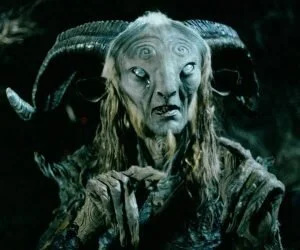More Great Folk Horror & Some Definitions
Normally we love spoiling the hell out of movies. Not today though! Today we’re just recommending good folk horror (and getting nerdy with definitions). Read on, spoiler-anxiety free.
Every Academic’s Favorite Pastime
We wanted to bring you a list of good Pagan horror we didn’t get to talk about last month. But there was a problem. In our search for Pagan horror, we came across a lot of Satanic cults and witches, as well as some stories and creatures from old folktales, but relatively little in the way of what we would call Pagan horror.
We brought you a post on The Wicker Man (1973), challenging the idea of Sgt. Howie as a martyr. We took you into the strange fusion of literal cut-throat Capitalism with Pagan rituals of human sacrifice portrayed in Kill List (2011). We picked apart the perspective of a man so good at playing the victim he finally got to be one in Midsommar (2019). And we explained why you definitely should watch the excellent hybrid essay/docudrama Häxan (1922), but why you should definitely not watch the offensively bad hatchet job recut from the 1970s of a different title that we won’t name because you shouldn’t watch it. But Häxan, we decided, isn’t really Pagan horror so much as Satanic witch horror, and in general, we’re a bit short on good Pagan horror to suggest, so instead, we’re going to tell you about some other great folk horror we came across.
First, though, being a curious reader, you might ask, “What’s the difference?” And that’s our chance to indulge every academic’s favorite pastime: making a definition no one cares about--except you, curious reader. You care. That’s why you come to us. For the good thinky talk without the jargon.
Paganism, Witchcraft, Satanism, Folklore, & What the Hell’s the Difference?
Let’s start with “Pagan,” a slur first applied by early Christians to describe polytheistic Romans. (Mind you, we’re going with Wikipedia here. This is a listicle, not a full on deep-dive. Get over it.) These same folks were also called “hellenes,” “gentiles,” and “heathens.” Christians, especially urban ones, associated them with ritual sacrifice and derided their beliefs, regarding Paganism as the religion of peasants. Historically, it’s been used to refer to any non-Christian belief. In general, though, “Pagan” has come to mean polytheism and nature worship within Christian-dominated cultures, especially in rural and remote areas.
In that sense, “Pagan horror” deals with Christian fears of those religions. We’re talking human sacrifice, ritual mutilation, and the perceived barbarity of other beliefs.
Sometimes witch horror Venn-diagrams its way into this category. The Blair Witch Project (1999) deals with a witch of the nature-worshipping variety, and the coven in Suspiria (1977 and the excellent 2018 remake) summons evil gods.
“Satanism,” (in the Christian anxiety sense, anyway), is all about worship of Satan and his devil and demon buddies. This gets dicey sometimes because there’s gray area in a lot of movies about whether their devils and demons come from Christianity or elsewhere. Unless there’s something explicit or clearly implied in a witch or cult horror film that makes it Christian-y--like 2013’s over-the-top, kitchen-sink horror movie The Conjuring--we assume the witches or cultists are Pagan or of some other non-Christian variety.
Like we noted above, the ideas of witchcraft in Häxan fit into this category, as does the titular being of 1989’s Warlock. (That brings up an interesting point about witches--that they’re almost always depicted as female, Warlock being a rare exception. But we’re keeping this short, so we’ll have to set that aside for now.)
Finally, the term “folklore” is an absolutely massive can of very academic worms that, again, we can’t possibly cover in this listicle, but we see it this way: “folklore” means stories and beliefs of the people. Most of the time, “people” means rural people, but not always--the beliefs of the Pagans in Kill List are held by rich and powerful corporate types. And most of the time, those stories and beliefs are at least a few generations old, if not downright ancient.
So, “folk horror” is a big umbrella that has room for witches, Pagan cults, Satanic cults, folktales, and communities of people whose beliefs and practices are frightening to “civilized” people.
So there you go, some definitions. And now, some folk horror classics.
Pan’s Labyrinth (2006)
Streaming on Netflix as of 4/02/2021
With a seemingly sinister faun, a human-like mandrake root, some creepy mantis-like fairies, and a so-called “pale man” who has eyeballs in his hands and eats two of the fairies, Director Guillermo del Toro’s award-winning horror fairytale follows Ofelia (Ivana Baquero), a girl living through early Francoist Spain.
Ofelia travels with her pregnant mother Carmen (Ariadna Gil) to live with (and apparently meet for the first time), her new stepfather, the ruthless Captain Vidal (Sergi López). While exploring the grounds of the cold, uninviting wilderness surrounding the military site, Ofelia discovers an old labyrinth, and within it, a mythical faun (Doug Jones). The creature believes she carries the immortal soul of Moanna, the Underworld princess who lost her memories when she came to the mortal world.
To return to the Underworld and reclaim her throne, Ofelia must complete three tasks--two fetch quests and a fake-out--given by the faun (not the Greco-Roman Pan, by the way, according to del Toro). In the midst of this fantastic myth, her mortal life unravels into tragedy and chaos. As her brother’s birth approaches, her mother’s health rapidly declines, and Captain Vidal reigns terror over everyone in and around the base in his attempts to weed out and slaughter political rebels five years after the Spanish Civil War.
With spectacular special effects and imagery that hold up fourteen years later and will probably continue to hold up for, well, ever--Pan’s Labyrinth offers a rich, imaginative childhood dreamscape, whimsically layered with brutal reality.
For Those in Peril (2013)
Streaming on Tubi as of 4/02/2021
Paul Wright’s 2013 debut feature follows Aaron (George MacKay), a teenager shunned by his tight-knit Scottish fishing community after returning the lone survivor from a boating accident that stole the lives of five other men, including his own brother. At first, Aaron claims to not remember the trauma. In response, the townsfolk treat him with suspicion and distrust, believing he’s responsible for their losses while he and his mother Cathy (Katie Dickie) attempt to navigate through their own grief. Plagued with survivor’s guilt, and eventually with erratic determination, Aaron’s behavior grows increasingly unhinged as he insists the others are still out there somewhere, still alive, and that he must find them.
It’s the mood evoked, not the plot or the mystery surrounding those lost at sea, that matters here. Quiet. Gray. Uncomfortable. The potential answers to all the film’s questions lie not in what’s said, but rather in what’s implied through the characters’ actions and the story’s tone. This is particularly true when home video flashbacks unveil the complexities of Aaron’s antagonistic relationship with his brother.
With a small but effective cast, Wright offers a raw and sometimes disturbing exploration of grief, trauma, survival, and the grand ferocity of the sea--embodied in the protagonist’s belief that a Loch Ness-like monster is responsible for the town’s tragedy. The title For Those in Peril refers to part of a repeated line in William Whiting’s celebrated hymn “Eternal Father, Strong to Save,” adding a folk music connection to this dark tale.
Picnic at Hanging Rock (1975)
Streaming on HBO Max as of 4/02/2021
Long before The Blair Witch Project and Paranormal Activity (2007) disturbed audiences with carefully staged subterfuge and marketing, Australian director Peter Weir rattled viewers with his adaptation of Joan Lindsay’s 1967 novel of the same title, a “true” tale about four women disappearing into the Bush. Though the events of Picnic At Hanging Rock (1975) are not factual, its performance of authenticity charges the film’s mysteries with real dread.
Picnic was also remade into a six-episode mini-series in 2018. The expanded runtime detracts from the overall dreaminess, but it’s an engaging and discomforting adaptation of Lindsay’s novel. Available on Amazon Prime as of 4/2/2021.
Some contemporary audiences might call Picnic too slow or its open ending unsatisfying, but it might be more appropriate to approach the film’s events as if a plague were enveloping the small town. The disappearance of the young girls and their teacher (and the aftermath) sneak into the lives of each supporting character, possessing them with grief, anger, and the disquiet of reckoning with the Unknown.
The film’s overwhelming anxiety and ambiguity share a lot of David Lynchian DNA, specifically his own small-town tragic mystery, Twin Peaks. In particular, the apparent leader of the vanished women, the enigmatic Miranda (Anne-Louise Lambert), evokes Lynch’s muse of misery, Laura Palmer (Sheryl Lee), especially in the ethereal way she’s rendered. Elsewhere, saturated colors lend the titular location of Hanging Rock an air of otherworldliness. The score oscillates from Mozart and Beethoven in scenes of wealthy Brits on holiday, to lone pan flute and wind buffeting the microphone in the lonely outback. Each of these decisions further emphasizes the film’s mystery and tensions, between colonizer and the land, between queer love and suppression, between question and answer.
The Witch: A New England folktale (2015)
Streaming, with premium subscription, on Hulu as of 4/02/2021
Robert Eggers’ The Witch, set in a New England farm in the 1630s, follows Thomasin (Anya Taylor-Joy) and her family’s terrifying encounters with Christian-y Satan-worshipping witchcraft deep in the wilderness after having been exiled from their Puritan community over a religious dispute. Early in the film, Thomasin plays peekaboo with her infant brother Samuel by a stream, until one time, when she peeks, he vanishes.
From there on out, the family crumbles. Every time something bad happens, they blame Thomasin, including for their own petty misdeeds. Katherine (Kate Dickie), the mother of the family, is thrown into a terrible grief that she tries and fails to stave off with constant prayer. Thomasin’s siblings, the fraternal twins Mercy and Jonas (Ellie Grainger and Lucas Dawson), take every opportunity to torment her. The selfishness and overbearing nature of her father William (Ralph Ineson) grow and spread throughout the family. And all of this drives Thomasin further and further from her family. Her only relief is in her bond with her brother Caleb (Harvey Scrimshaw).
The Witch is brooding and unsettling, thanks in no small part to its methodical pacing and its bleak, crushing depiction of life in the wilderness, life in a rigid Puritan family, and life as a young girl loathed by said family and driven to find liberation in spoilery ways we won’t talk any more about.
Other Folk Horror Worth Watching
The Blood on Satan’s Claw (1971)
Witchfinder General (1968)
The Babadook (2014)
Without Name (2016)
Hereditary (2018)
Sleepy Hollow (1999)
Suspiria (1977, remade 2018)












